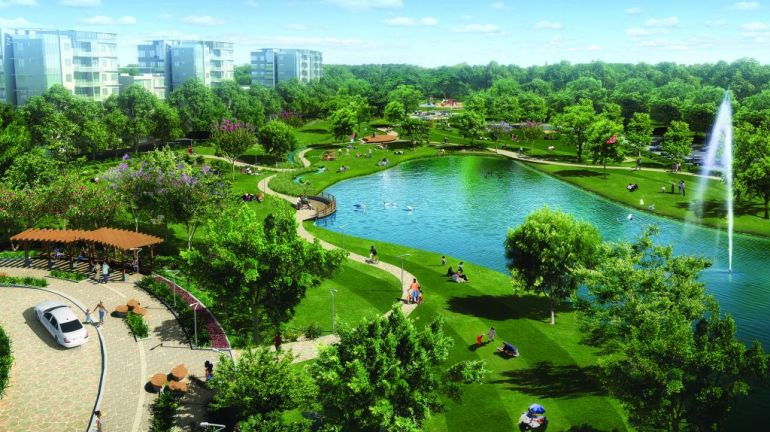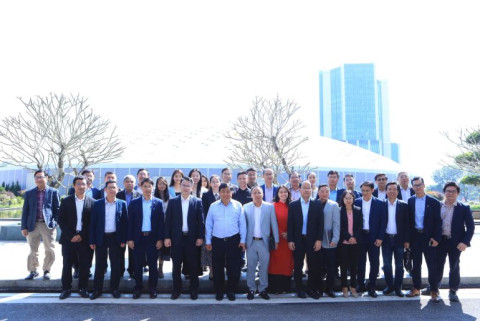The reasons why Vietnam should strive to build carbon cities
- 220
- Business
- 16:31 20/02/2024
DNHN - Experts say that to deal with the threats of climate change and environmental pollution, building carbon cities has become an important trend in sustainable urban development.
Vietnam is facing a large amount of carbon emissions from polluting energy sources such as coal and oil. Building carbon cities aims to reduce dependence on these energy sources by increasing the use of renewable energy sources and saving energy. By using clean and smart energy systems, carbon cities can reduce carbon emissions and contribute to the global goal of reducing carbon emissions.
Building carbon cities not only helps reduce carbon emissions but also creates a better living environment for residents. Carbon cities are often designed with green spaces, public parks and efficient public transport systems. This helps to create clean air, reduce noise and improve people’s quality of life.
Vietnam is one of the countries most seriously affected by climate change, with many natural disasters such as floods and droughts. Building carbon cities can help improve Vietnam’s resilience to climate change. By integrating environmental and climate protection measures into urban planning, we can minimise the impact of climate change and create a safer living environment for residents.

Building carbon cities is not only an environmental protection measure but also creates opportunities for sustainable economic development. Investing in smart infrastructure and using clean energy can promote the development of new industries, create jobs and enhance Vietnam’s economic competitiveness in the international market. At the same time, the construction of carbon cities also attracts the attention and support of international organisations, opening up opportunities for cooperation and sharing of experiences with international partners.
Concerning this issue, Dr Thai Duy Sam, Vice Chairman and General Secretary of the Vietnam Building Materials Association, said that building materials industry enterprises have been actively implementing green production development, both in terms of technology and raw materials.
Meanwhile, Ms Nguyen Thi Thanh My, Deputy Director of the Ho Chi Minh City Department of Natural Resources and Environment, said that the city aims to reduce greenhouse gas emissions by 10% by 2030 and move towards a low-carbon economy. To achieve this, the unit has actively instructed facilities and enterprises in five areas: industrial production, transport, energy, agricultural production activities and waste treatment to carry out steps to inventory and report the amount of emissions in production and business activities.
“At the same time, encourage businesses to proactively develop plans to reduce greenhouse gas emissions in production and business; promote the application of technology in the collection and treatment of wastewater and waste in the direction of regeneration to reduce greenhouse gas emissions”, she said.
According to experts, successfully building and developing a low-carbon urban model is not entirely simple, because most of the requirements for reducing carbon emissions and responding to climate change have not been considered or integrated into urban development planning or the implementation of planning has not been good, so the negative impacts of climate change are still occurring in some places. Low-carbon products and services are all new products that require a lot of effort, cost and time to invest, so the cost will be relatively high compared to traditional products and services. Therefore, it is necessary to adjust appropriate urban management measures; and develop low-carbon industrial urban areas based on available resources and the industrial advantages of the locality in addition to developing low-carbon tourism, and high-tech industry to reduce costs to the lowest level.
In summary, Vietnam should aim to build carbon cities to reduce carbon emissions, improve the quality of the living environment, enhance resilience to climate change and encourage sustainable economic development. This is an important trend in urban development and brings many benefits to Vietnam in terms of the environment, people’s lives and economic development. Vietnam needs to promote research and investment and promote policies and plans to support the construction of carbon cities to achieve a sustainable and prosperous future.
Nghe Nhan
Related news
- Connecting Leaders, Shaping the Future: Strategic Leadership Planning Meeting – CorporateConnections Hanoi A
- Sunlight - Unilever Vietnam Recognized for Outstanding Contributions to the National Initiative Supporting Women Entrepreneurs
- Deputy Prime Minister Nguyễn Chí Dũng: “The country’s major challenges weigh heavily on my mind — and we must resolve them together.
- Unitsky String Technologies signs cooperation agreements with three Vietnamese partners, opening a new direction for smart mobility and sustainable development
- When artists do business – livelihood is no poetry!
- Before the D‑day to abolish flat‑rate tax: Fear of technology and costs leave small traders struggling to adapt
- Vietnamese enterprises at a crossroads: the impact of a potential US–China deal
- "Digital technicians" must not be forgotten if Vietnam aims to meet its strategic goals
- HDBank: Impressive profit growth, leading in profitability and advancing international integration
- TNI King Coffee sued for over VND 5 Billion in unpaid debts
- VINASME and Jeonnam Technopark Sign MOU on technology cooperation, human resource training, and trade promotion
- Vietnamese entrepreneurs strengthen ASEAN connectivity in the digital iIntegration era
- Prime Minister: Vietnam aims to become a regional logistics hub
- Vietnam upgraded to Secondary Emerging Market by FTSE Russell
- Hanoi’s economy grows 7.92% in first nine months of 2025, FDI surges nearly threefold
- Vietnam’s strong gdp growth fails to ease labor market distress
- US tariffs on Brazil propel Vietnam’s pangasius into global spotlight
- VietLeap AI Accelerator launches: A strategic springboard for Vietnam’s AI startups
- CICON expands strategic alliances: A new step forward in Vietnam–Korea business connectivity
- What must Vietnamese enterprises do to maintain their position in the global supply chain?
Đọc thêm Business
Connecting Leaders, Shaping the Future: Strategic Leadership Planning Meeting – CorporateConnections Hanoi A
"Your network is your most powerful flowing asset. It generates value, multiplies opportunities, and accelerates your influence across borders."
Innovative ESG enterprise: Trạm Xe Việt startup proposes solutions to build a green mobility ecosystem
As Vietnam commits to achieving Net Zero by 2050 and tightens emissions standards, the transportation sector faces unprecedented pressure to transform.
Deputy Prime Minister Nguyễn Chí Dũng: “The country’s major challenges weigh heavily on my mind — and we must resolve them together.
On the morning of November 26, 2025, Deputy Prime Minister Nguyễn Chí Dũng chaired a high-level working session at the National Innovation Center (NIC) in Hòa Lạc.
Unitsky String Technologies signs cooperation agreements with three Vietnamese partners, opening a new direction for smart mobility and sustainable development
The signing ceremony took place in Minsk, Belarus, on November 28, 2025.
Before the D‑day to abolish flat‑rate tax: Fear of technology and costs leave small traders struggling to adapt
From 1 January 2026 the flat‑rate tax regime will be abolished. Small business households will be required to declare tax based on actual revenue. MISA supports the transition with technology to help micro‑merchants adapt smoothly and transparently.
Vietnamese enterprises at a crossroads: the impact of a potential US–China deal
As the world closely monitors every shift in US-China relations, emerging signals of a strategic agreement between the two global powers are raising hopes for global economic stability.
HDBank: Impressive profit growth, leading in profitability and advancing international integration
Ho Chi Minh City Development Joint Stock Commercial Bank (HDBank, stock code HDB) announced its consolidated profit before tax for the first 9 months of 2025 reached VND 14,803 billion, marking a 17% increase year-on-year (YoY).
TNI King Coffee sued for over VND 5 Billion in unpaid debts
On October 21, 2025, the People’s Court of District 10 in Ho Chi Minh City officially accepted a civil lawsuit concerning a commercial contract dispute between TKT Vietnam Plastic Packaging Joint Stock Company and TNI King Coffee Co., Ltd.
VINASME and Jeonnam Technopark Sign MOU on technology cooperation, human resource training, and trade promotion
On October 15, 2025, in Hanoi, VINASME and Jeonnam Technopark (Korea) signed an MOU to promote trade, advance technology transfer, and develop human resources between enterprises of both nations.
Vietnamese entrepreneurs strengthen ASEAN connectivity in the digital iIntegration era
On the occasion of Vietnam Entrepreneurs’ Day (October 13), an international event themed “Integration – Innovation – Sustainable Development” was solemnly held in Ho Chi Minh City.











